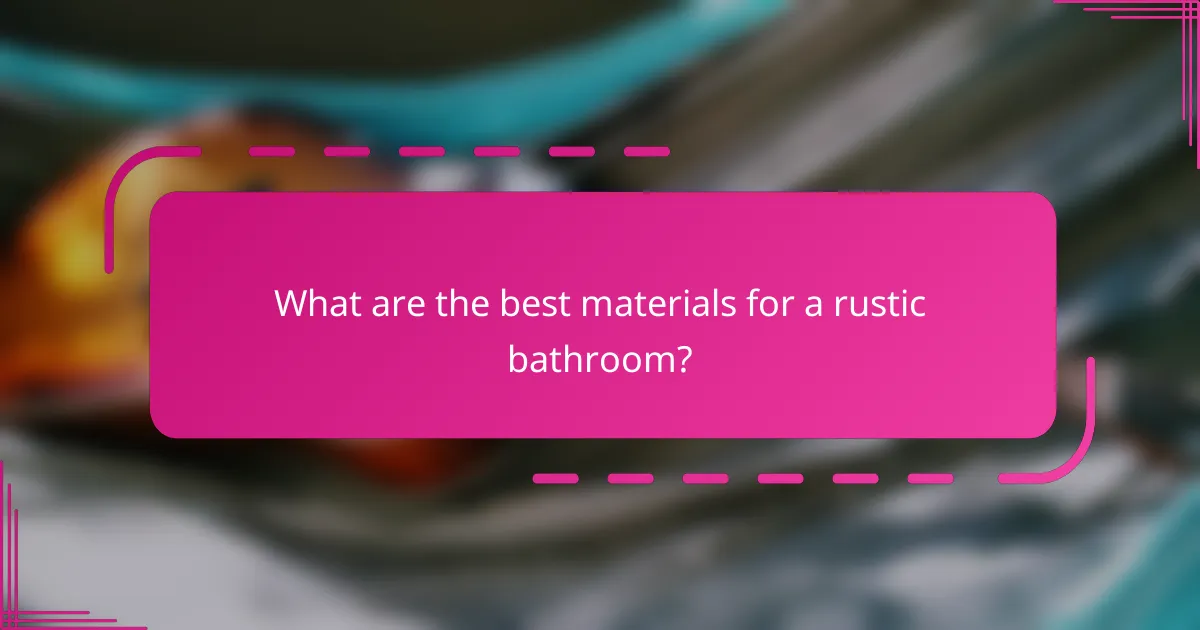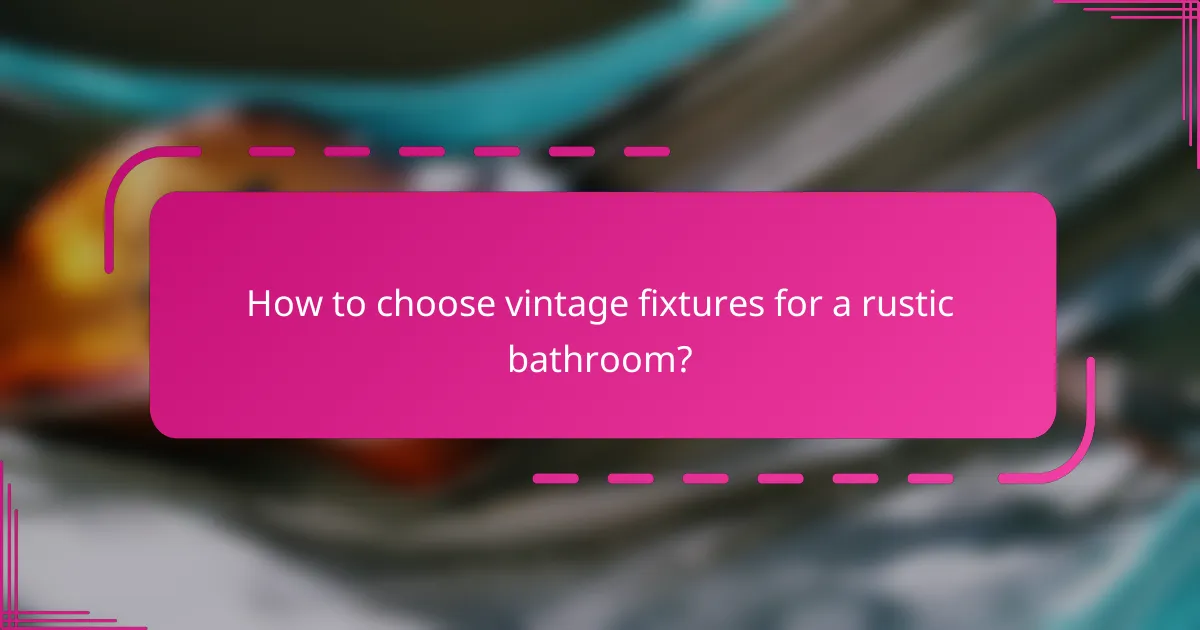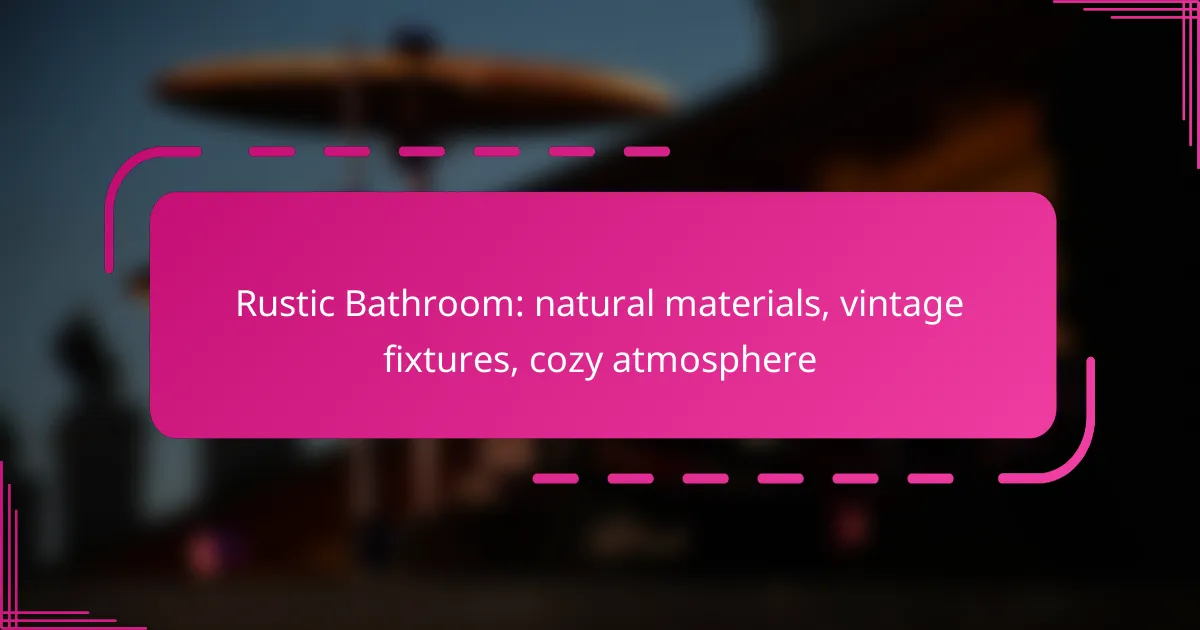A rustic bathroom embodies a warm and inviting atmosphere by incorporating natural materials and vintage fixtures. Utilizing elements like reclaimed barn wood, natural stone tiles, and brass or copper accents enhances the cozy feel while celebrating the beauty of nature. By selecting authentic vintage pieces, you can create a space that reflects timeless charm and comfort.

How to create a rustic bathroom atmosphere?
To create a rustic bathroom atmosphere, focus on using natural materials, vintage fixtures, and cozy elements that evoke a warm, inviting feel. Incorporate textures and colors found in nature to enhance the overall aesthetic.
Use reclaimed wood for cabinetry
Reclaimed wood adds character and warmth to a rustic bathroom. Look for wood sourced from old barns or factories, which often features unique grains and finishes. This not only supports sustainability but also provides a rich, textured look.
When selecting reclaimed wood, consider finishes that highlight its natural beauty while protecting it from moisture. A matte sealant can preserve the rustic charm without making it look overly polished.
Incorporate vintage lighting fixtures
Vintage lighting fixtures can dramatically enhance the rustic vibe of your bathroom. Look for items like wrought iron sconces or antique pendant lights that reflect the charm of bygone eras. These fixtures often come in warm tones that complement natural materials.
Consider using Edison bulbs for a soft, nostalgic glow. Ensure that the lighting is adequate for tasks like shaving or applying makeup, but also creates a cozy ambiance for relaxation.
Choose natural stone for countertops
Natural stone countertops, such as granite, slate, or soapstone, provide durability and a rustic aesthetic. Each stone type has its unique patterns and colors, allowing for personalization in your design. Opt for honed finishes for a more matte, natural look.
Keep in mind that natural stone requires regular sealing to maintain its appearance and prevent staining. This maintenance is a small trade-off for the beauty and longevity these materials offer.
Add cozy textiles like woven rugs
Woven rugs can add warmth and comfort to a rustic bathroom. Choose materials like cotton or jute that are durable and easy to clean. Patterns inspired by nature or traditional designs can enhance the rustic theme.
Layering rugs can create a more inviting atmosphere. Consider placing a larger jute rug underneath a smaller, patterned one to add depth and texture to the space.

What are the best materials for a rustic bathroom?
The best materials for a rustic bathroom include reclaimed barn wood, natural stone tiles, and brass or copper fixtures. These elements create a warm, inviting atmosphere while emphasizing natural beauty and vintage charm.
Reclaimed barn wood
Reclaimed barn wood is a popular choice for rustic bathrooms due to its unique character and sustainability. Sourced from old barns and buildings, this wood often features weathered textures and rich colors that add warmth to the space.
When using reclaimed wood, consider its treatment for moisture resistance, especially in areas like vanities or shelving. Proper sealing can help prevent warping and damage from humidity.
Natural stone tiles
Natural stone tiles, such as slate, limestone, or travertine, provide a timeless and durable flooring option for rustic bathrooms. These materials offer a variety of colors and textures, allowing for creative design choices that enhance the rustic aesthetic.
Keep in mind that stone tiles can be porous, so applying a sealant is essential to protect against water damage and staining. Additionally, consider using larger tiles to minimize grout lines, which can contribute to a cleaner look.
Brass or copper fixtures
Brass and copper fixtures are ideal for adding vintage flair to a rustic bathroom. Their warm tones complement natural materials beautifully and can develop a lovely patina over time, enhancing the rustic charm.
When selecting fixtures, look for high-quality options that resist tarnishing and corrosion. Regular maintenance, such as polishing, can help maintain their appearance and prolong their lifespan.

How to choose vintage fixtures for a rustic bathroom?
Selecting vintage fixtures for a rustic bathroom involves focusing on authentic materials and designs that enhance the cozy atmosphere. Look for items that reflect the charm of bygone eras while ensuring they fit your overall aesthetic and functional needs.
Look for antique shops
Antique shops are treasure troves for vintage bathroom fixtures. These shops often carry unique items like clawfoot tubs, ornate faucets, and vintage mirrors that can serve as focal points in your bathroom. When visiting, check the condition of each piece and inquire about its history to ensure authenticity.
Be prepared to negotiate prices, as many antique shops are open to offers. A budget range of a few hundred to a couple of thousand dollars can yield stunning finds, depending on the rarity and condition of the fixtures.
Consider online marketplaces like Etsy
Online marketplaces such as Etsy provide a vast selection of vintage fixtures from various sellers. You can find everything from reclaimed sinks to antique light fixtures, often with detailed descriptions and photos. This option allows you to shop from the comfort of your home and compare prices easily.
When purchasing online, pay attention to shipping costs and return policies. Many sellers offer custom shipping options, which can affect the overall price. Setting a budget of around $50 to $500 can help you find quality pieces without overspending.
Visit local flea markets
Local flea markets can be excellent venues for discovering vintage bathroom fixtures at affordable prices. Vendors often sell unique items that may not be found in traditional stores, including vintage tiles, sinks, and decorative elements. Arriving early can give you the best selection.
Bring cash and be ready to haggle; prices can often be negotiated. A budget of $20 to $300 is typically sufficient for finding charming fixtures that can enhance your rustic bathroom’s character.

What are the key design elements of a rustic bathroom?
A rustic bathroom typically features natural materials, vintage fixtures, and a cozy atmosphere that evokes a sense of warmth and simplicity. Key design elements include earthy color palettes, ample natural light, and textured surfaces that enhance the overall aesthetic.
Earthy color palettes
Earthy color palettes are essential in creating a rustic bathroom ambiance. Shades like warm browns, soft greens, and muted grays reflect the natural world and promote a calming environment. Consider using paint, tiles, or natural wood finishes in these tones to establish a cohesive look.
To enhance the rustic feel, you can incorporate accent colors inspired by nature, such as deep blues or rusty reds. These can be introduced through accessories like towels, rugs, or decorative items, adding depth without overwhelming the space.
Natural light sources
Natural light is crucial in a rustic bathroom, as it highlights the textures and colors of the materials used. Large windows, skylights, or glass doors can bring in sunlight, making the space feel airy and inviting. When planning your layout, prioritize these features to maximize daylight.
Consider using sheer window treatments to allow light while maintaining privacy. If natural light is limited, opt for warm artificial lighting that mimics daylight, enhancing the cozy atmosphere typical of rustic design.
Textured surfaces
Textured surfaces play a significant role in achieving a rustic bathroom aesthetic. Materials such as reclaimed wood, stone, and ceramic tiles add visual interest and tactile appeal. Incorporating these elements can create a layered look that feels both organic and inviting.
When selecting surfaces, aim for a mix of textures to enhance the rustic charm. For example, pair smooth ceramic sinks with rough-hewn wooden cabinets or stone countertops. This contrast not only adds character but also emphasizes the natural materials that define rustic design.

How to maintain a rustic bathroom?
Maintaining a rustic bathroom involves regular cleaning and care for natural materials and vintage fixtures to preserve their charm and functionality. Focus on using gentle methods that enhance the cozy atmosphere while preventing damage.
Regular cleaning with natural products
To keep a rustic bathroom looking its best, use natural cleaning products that are effective yet gentle on surfaces. Ingredients like vinegar, baking soda, and essential oils can clean without harsh chemicals, preserving the integrity of wood and vintage fixtures.
Establish a cleaning routine that includes wiping down surfaces weekly and deep cleaning monthly. Pay special attention to areas prone to moisture, such as around the sink and shower, to prevent mold and mildew.
Periodic sealing of wood surfaces
Wood surfaces in a rustic bathroom should be sealed periodically to protect against water damage and wear. Depending on the humidity and usage, consider resealing every six months to a year with a suitable wood sealant that is safe for bathrooms.
When sealing, ensure the wood is clean and dry. Apply the sealant evenly, following the manufacturer’s instructions for best results. This not only preserves the wood but also enhances its natural beauty, maintaining the cozy atmosphere of your rustic space.

What are the costs associated with a rustic bathroom renovation?
The costs of a rustic bathroom renovation can vary widely based on materials, labor, and design choices. Generally, homeowners can expect to spend anywhere from a few thousand to over twenty thousand dollars, depending on the extent of the renovation and the quality of materials used.
Material Costs
Natural materials are a hallmark of rustic bathroom designs, including wood, stone, and ceramic. For instance, reclaimed wood for cabinetry or flooring can range from $5 to $15 per square foot, while natural stone tiles may cost between $10 and $30 per square foot. Budgeting for these materials is essential, as they can significantly impact overall costs.
Additionally, vintage fixtures such as faucets and sinks can add character but may come at a premium. Expect to pay anywhere from $100 to $500 for unique, vintage-style pieces. Shopping at flea markets or online marketplaces can help find more affordable options.
Labor Costs
Labor costs for a rustic bathroom renovation typically range from $50 to $150 per hour, depending on the contractor’s experience and location. It’s advisable to obtain multiple quotes to ensure competitive pricing. Some homeowners may choose to handle smaller tasks themselves, such as painting or installing fixtures, to save on labor costs.
When hiring professionals, ensure they have experience with rustic designs, as this can influence the quality and authenticity of the finished space. Clear communication about your vision can help avoid costly mistakes.
Additional Expenses
Beyond materials and labor, consider additional expenses such as permits, plumbing, and electrical work. Depending on local regulations, permits can cost anywhere from $50 to several hundred dollars. If your renovation involves moving plumbing or electrical systems, budget for these changes, which can add significantly to the overall cost.
Lastly, don’t forget about finishing touches like lighting, mirrors, and decor. These can range from a few hundred to several thousand dollars, depending on your choices. Prioritize your spending to ensure the most impactful elements are addressed first.
